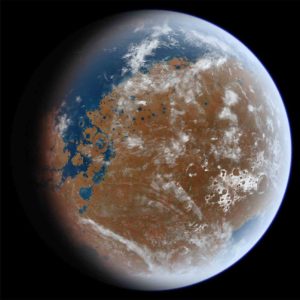The Other Blue Planet
Genesis 1:16b
“He made the stars also.”
 Our own Earth is often described as the Blue Planet because that is how it looks from space, where the large surface covering of water (about 77%) reflects light in the blue region of the spectrum. Mars, by contrast, is the Red Planet. Its rocky, desert surface has a reddish color about it, and photographs from the planet’s surface, taken by various robot probes, show the sky with a light pink hue.
Our own Earth is often described as the Blue Planet because that is how it looks from space, where the large surface covering of water (about 77%) reflects light in the blue region of the spectrum. Mars, by contrast, is the Red Planet. Its rocky, desert surface has a reddish color about it, and photographs from the planet’s surface, taken by various robot probes, show the sky with a light pink hue.
Modern astronomers have suggested that Mars once had a lot more water on it than it has today; there is a little water in the form of ice at the poles. Many surface features have an appearance which might suggest that they were formed by water. One such example would be the Ma’adim Vallis, which is over 430 miles long and over a mile deep in places. These statistics make it bigger than the Grand Canyon, and it is suggested that Ma’adim may have formed by water erosion.
Such large amounts of water might have suggested a different environment than that of today. Indeed, recent articles have postulated an ocean covering 20% of the surface of Mars, with an atmosphere, richer in water than today, giving the atmosphere an appearance of blue.
Is it possible that Mars could have had such an ocean and atmosphere? We have to say that of course it is possible. As biblical creationists, we would dispute the timescale for the removal of that water, as it could not have taken millions of years. It is speculation, but perhaps Adam, looking up at the heavens, saw a blue “star”, where today Mars appears red in the sky. Author: Paul F. Taylor
Prayer: We read that the “Heavens declare the glory of God”. As we learn more about planets and stars, in fact we are learning more about the greatness of God. Amen.
Ref: The Other Blue Planet, < http://www.telegraph.co.uk/science/2017/12/20/mars-looked-35-billion-years-agoand-water-still-says-oxford/ >, accessed 12/26/2017. Image: Creative Commons Attribution Share-Alike 3.0 Unported.